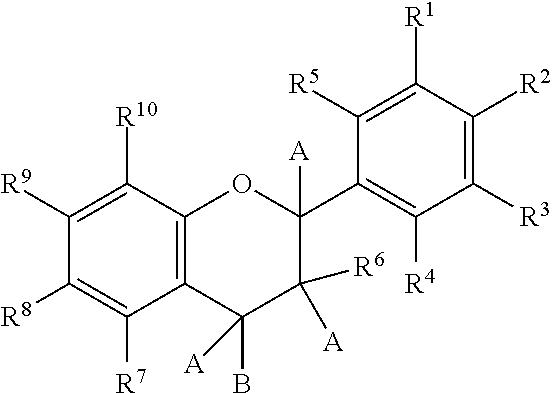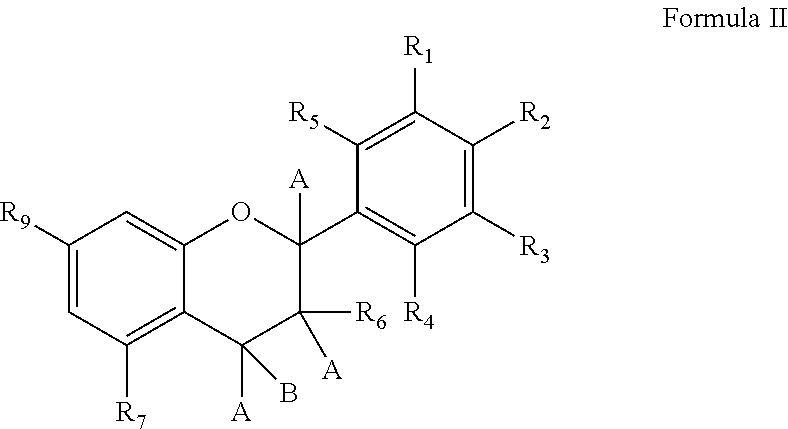Novel analogues of epicatechin and related polyphenols
an analogue and polyphenol technology, applied in the field of new analogues of epicatechin and related polyphenols, can solve the problems of undesirable pharmacodymanics and pharmacokinetic profiles, low potency,
- Summary
- Abstract
- Description
- Claims
- Application Information
AI Technical Summary
Benefits of technology
Problems solved by technology
Method used
Image
Examples
example 1
[0143]Synthesis of (R,E)-2-(3,4-dihydroxyphenyl)-5,7-dihydroxychroman-3-one oxime [1001]
[0144]Step 1: Synthesis Tetrabenzylated Catechin [20] from Catechin [19]
[0145]To a stirred solution of [19] (1.0 g, 3.4 mmol) in DMF, anhydrous K2CO3 (2.3 g, 17.0 mmol) was added at 0° C. under nitrogen atmosphere. After an additional stirring at this for 15 minutes at same temperature, benzyl bromide (2.0 ml, 17.0 mmol) was added drop-wise. The reaction temperature was allowed to increase up to 25° C. and stirring was continued for overnight. Consumption of [19] was monitored by TLC. After complete consumption of [19], water (50 ml) was added and organic layer was extracted with ethyl acetate (3×100 ml). The combined organic layers were washed with water, brine and dried over sodium sulphate. The organic layer was concentrated to afford light brown sticky material which was further purified using silica gel column chromatography using 8% ethyl acetate in hexane as eluent to afford [20] as white ...
example 2
[0152]Synthesis of (2R,3R)-2-(2,3-dihydroxyphenyl)-3-fluorochroman-5,7-diol [1010]
[0153]Step 1: Synthesis of [1010] from Catechin [19]
[0154]To a stirred solution of [19] (0.10 g, 0.34 mmol) in Dry DCM at −10° C. was added DAST (0.20 ml, 1.0 mmol) dissolved in DCM to form a solution. The stirring was continued for 2 h before addition of saturated NaHCO3 followed by extraction with DCM (2×50 ml). The combined organic layer was washed with brine and dried over sodium sulphate and concentrated to afford light brown sticky material. The crude reaction mixture was purified using Flash silica gel column and 1% MeOH in DCM as eluent to afford 1014 (0.01 g, 10%) as a light yellowish sticky material; ESIMS: 293[M30 +1].
example 3
[0155]Synthesis of (2R,3R)-2-(3,4-dihydroxyphenyl)-3-aminochroman-5,7-diol [1009]
[0156]Step 1: Synthesis of [23(A+B)] from [21]
[0157]To a stirred solution of [21] (0.50 g, 0.77 mmol) in dry THF, benzylamine (0.18 ml, 1.5 mmol) was added at room temperature under nitrogen atmosphere. After an additional stirring at this for 15 minutes at same temperature, acetic acid (3-4 drops) was added drop-wise. Further stirring at this temperature for 1 h, NaCNBH3 (0.09 g, 1.5 mmol) was added. Consumption of [21] was monitored by TLC. After complete consumption of the starting material, water (50 ml) was added and organic layer was extracted with ethyl acetate (3×100 ml). The combined organic layers were washed with water, brine and dried over sodium sulphate. The organic layer was concentrated to afford light brown sticky material which was further purified using silica gel column chromatography using 5% ethyl acetate in hexane as eluent to afford [23] (0.21 g, 36%) and 15 (0.07 g, 13%) as a li...
PUM
| Property | Measurement | Unit |
|---|---|---|
| Temperature | aaaaa | aaaaa |
| Temperature | aaaaa | aaaaa |
| Composition | aaaaa | aaaaa |
Abstract
Description
Claims
Application Information
 Login to View More
Login to View More - R&D
- Intellectual Property
- Life Sciences
- Materials
- Tech Scout
- Unparalleled Data Quality
- Higher Quality Content
- 60% Fewer Hallucinations
Browse by: Latest US Patents, China's latest patents, Technical Efficacy Thesaurus, Application Domain, Technology Topic, Popular Technical Reports.
© 2025 PatSnap. All rights reserved.Legal|Privacy policy|Modern Slavery Act Transparency Statement|Sitemap|About US| Contact US: help@patsnap.com



